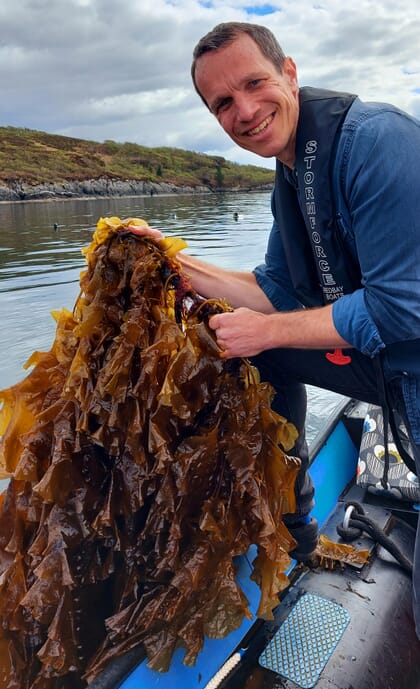
To research his book The Seaweed Revolution, Doumeizel spoke to "an impressive pioneering tribe of seaweed researchers" who have been working in the field for up to 40 years
It was when working for the French government in Africa that Doumeizel first began to comprehend the scale of the hunger and poverty facing so many people on the planet and, after 20 years working to improve standards in the food sector, he decided to return to his roots, joining the UN Global Compact in 2020, with a particular focus on seaweed’s potential to help feed the world.
“We have a fast-growing population, we already have 1 billion people starving and we have 215,000 extra people to feed every day. But at the same time, from what I’ve witnessed, our food system is not efficient anymore and destroys the environment and our climate – generating water scarcity, soil degradation and so on – we need to find a new way,” he explains.
“And, although 71 percent of our planet is covered by ocean, it contributes only 3 percent of our food. We have overexploited almost third of our planet, but we are still in the Stone Age, like hunter-gatherers, when it comes to the ocean,” he adds.
This realisation was a major incentive for Doumeizel to turn to seaweed, as were some of his personal experiences of food production.
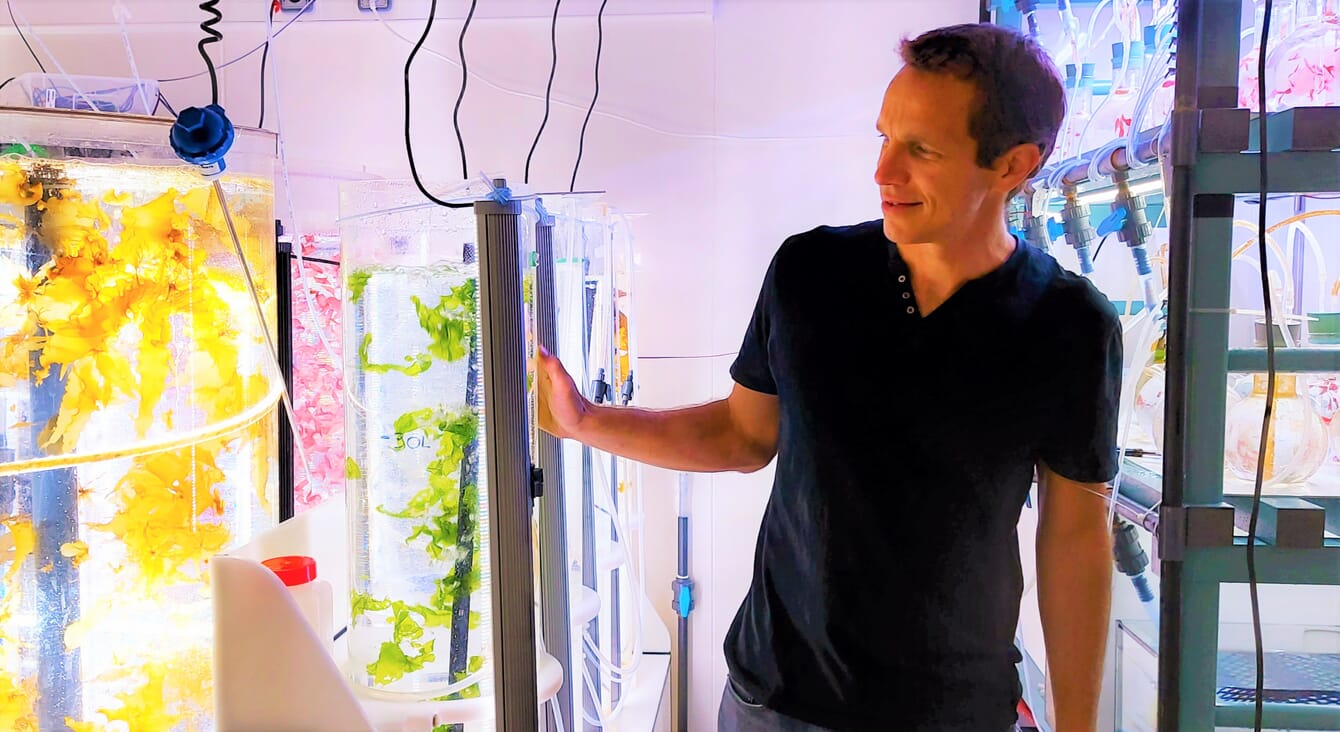
“When working on the certification of aquaculture projects, including salmon farms, I realised that even certified farms were not truly sustainable. Why were we growing fish at the highest trophic level, which needed to be fed diets based on smaller fish or on soy that might have contributed to the deforestation of Amazonia and then travelled half of the world, when you have local seaweed, full of protein next door?” he asks.
He therefore decided that looking at the other end of the trophic spectrum made more sense.
“We have to start at the lowest trophic level and so, if we provide habitat and feed and food for the rest of food chain, seaweed is the best place to start. That’s why we need a seaweed revolution, we have to move to the next phase, like the Neolithic Revolution, when we started farming the land 12,000 years ago,” he explains.
Doumeizel is well placed to make an impact in the field – both through his role with the UN and as the head of the Global Coalition of Seaweed Stakeholders, which was founded by Lloyd’s Register Foundation.
“We are more than 1,000 stakeholders in the coalition and we are trying to advocate for this seaweed revolution to come. Seaweed is a very small and highly fragmented industry, especially in the West, so we have to get together to launch the revolution, to feed the world, and to address the world’s most pressing challenges,” he argues.

He was also integral to the launch of The Seaweed Manifesto in 2020 – a common statement on the potential of the seaweed sector, which was drawn up by a range of academics and published by the UN, who saw seaweed’s huge potential to address a wide range of the UN's Sustainable Development Goals (SDGs).
Challenges facing the sector
While Doumeizel is hugely optimistic about seaweed he is also aware of the challenges the sector faces – challenges that vary between the established and nascent seaweed growing regions.
“In the West the science gap is the main challenge. We still don’t know how to cultivate our seaweed in the North Atlantic. If you live in Scotland but only know how to grow guava, banana and rice, it’s not going to help you start to farm. Unfortunately we only really know how to cultivate the Asian algal species and it’s not easy to learn our own – the ocean is a complex environment, you cannot use pesticides, there’s a lot of science needed and we need a new generation of marine biologists who are focusing specifically on seaweed,” he argues.
He also emphasises the need to increase consumer appetite for seaweed, especially as a source of food.
“Creating the market is the second challenge – we need to get people to eat seaweed and to understand that seaweed is good for our bodies and our planet and is delicious too. We need it to become mainstream, like it is in Asia where people realise its health benefits – it’s as good a food as you can get, it’s a nutritional bomb, with no fat and no sugar,” he reflects.
Despite the impressive scale of Asia’s seaweed sector – which accounts for 99 percent of global production – Doumeizel notes that there’s a need to branch out beyond the conventional uses, such as alginates, hydrocolloids and carrageenan.
“Although there’s a strong tradition of eating seaweed in Asia, cultivating it is relatively new. They now need to improve cultivation again and to do it better. They also need to look at other applications – they are not very advanced in terms of using seaweed in animal feeds, fertilisers, medicines or for carbon sequestration,” he explains.
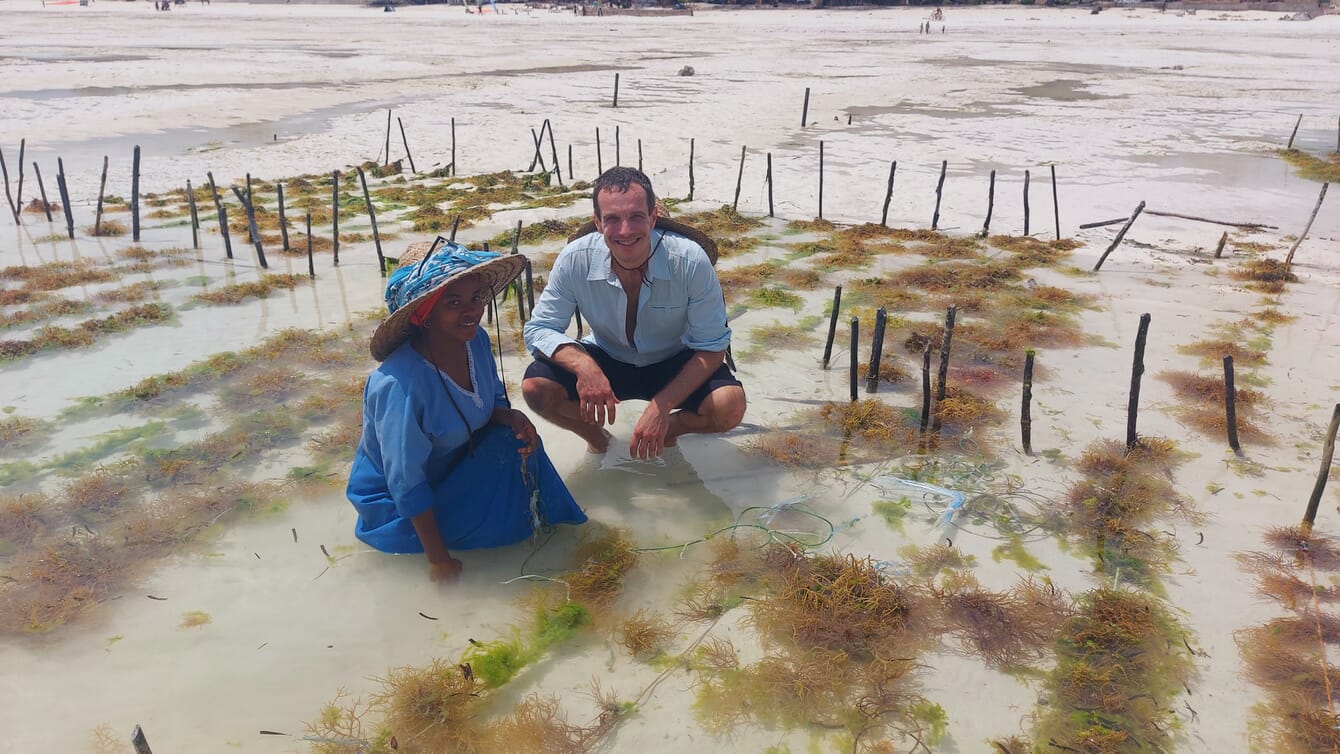
Doumeizel also notes that processing needs to become more sophisticated.
“At the global level we all need to be better at developing biorefineries to extract and valorise the various compounds – even in South Asia they valorise carrageenan, which is one of the compounds, but the remaining 75 percent is waste. It’s only in South Asia and Africa, where labour costs are low, that you can do that economically,” he points out.
“One type of seaweed could produce biostimulants, animal feeds and bioplastics if processed efficiently,” he adds.
Applications for seaweed
While improving food security is Doumeizel’s main goal, he is well aware that the potential applications for seaweed are plentiful.
“There are over 12,000 different species of seaweed and a green seaweed and a red seaweed are genetically more different than a fungi is to an elephant – we’re talking about totally different organisms with totally different applications,” he points out.
“While some of them will be good for food, I also think biostimulants made from seaweed will be huge – we’ve not yet realised the need we will have to replace fertilisers, because we’ll be running short of phosphates and nitrogen,” he adds.
“I think animal feed will also be big – we cannot expect to change people’s diets overnight, they will still want to enjoy a good chicken or a T-bone steak. That’s fine, but let’s feed these animals on seaweed instead,” he continues.
He also aware that it’s important to make seaweeds more palatable.
“Some of them are delicious, but we need to understand how to cook them, hopefully chefs will start to support this new gastronomy,” Doumeizel observes.
Applications that should be given a miss
Although Doumeizel is very enthusiastic about a range of uses for seaweeds, he is sceptical about some of the claims relating to the sector.
“I think we all now agree that making biofuels from seaweed is not going to happen. It was how this hype for seaweed started about 10 years ago, but the carbon content is way too low and you are wasting a great resource for a few litres of oil,” he argues.
“And I think that the idea of sinking seaweed in the deep ocean as a way to sequester carbon is quite worrying. It might look nice – seaweed has a clear potential to sequester carbon in the deep ocean, as there are no bacteria there so it can be stored for hundreds, if not thousands, of years – but we don’t know what the consequences on the deep ocean ecosystem might be and we don’t want to inadvertently create another problem, so I would be very cautious about this concept,” he adds.
Targeted investment
Doumeizel is aware that investment is one of the crucial catalysts for the seaweed sector to fulfil its true potential and he suggests that private sector investors should concentrate on the downstream side of the value chain – particularly in biorefineries.
“Growing seaweed is still very much about R&D and biology, so I feel that should mainly be supported by the public sector, but I feel that the biorefinery and processing part needs a lot of private investment,” he reflects.
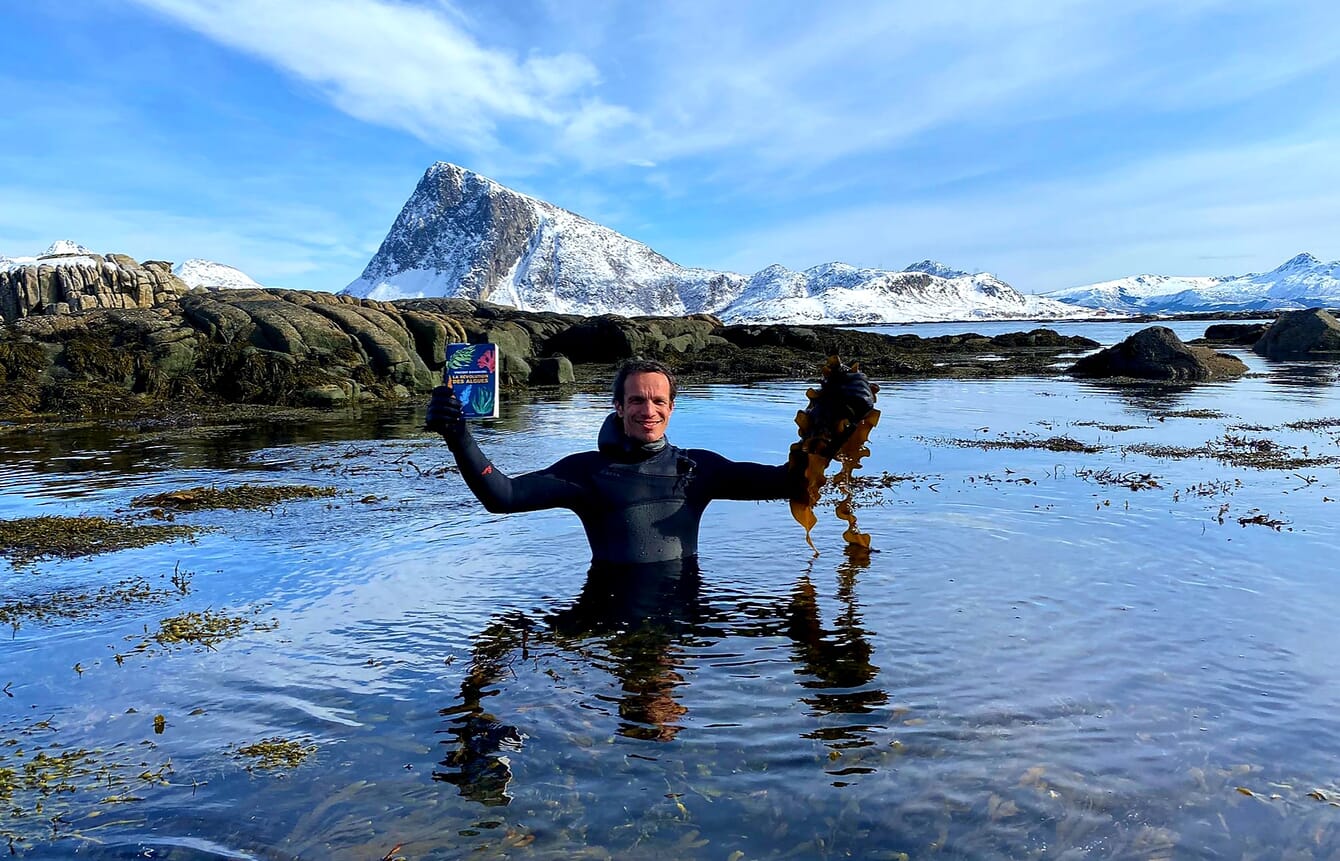
Meanwhile, in terms of regions to invest in, Doumeizel believes that Europe, the US and – in particular – Africa and India have the greatest potential.
“There will be the fastest growing need for food in Africa and they have some very nice seaweed projects already starting there,” he observes.
He also points to the huge potential of the extreme latitudes – noting the huge coastlines and ever-improving growing conditions for seaweed in areas such as Canada, Alaska, Scandinavia and Siberia.
The Seaweed Revolution
In the course of his new book Doumeizel suggests that seaweed has already played a significant role in the development of society over thousands of years, yet its role could be even more significant in the coming decades.
“Seaweed has been eaten throughout our history and now it could help us address the biggest crises facing this generation – climate change, environmental crisis, social crisis and food crisis. Each chapter explores the ways it can help – from feeding people, to feeding animals, to sequestering carbon – build a better world,” he explains.
In order to research the book Doumeizel spoke to many of the academics and researchers who have been involved in seaweed research for decades.
“There is an impressive pioneering tribe of seaweed researchers, many of whom have been working in the field for 40 years and speaking with them revealed many different seaweed stories, but most of them were not aware of the bigger picture – this is a story that needs to be told,” he points out.
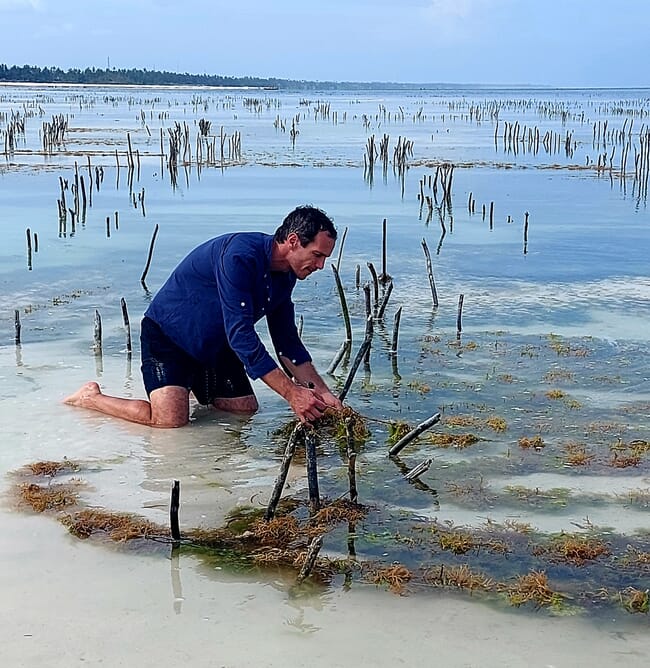
This is backed up by the range of colourful examples he cites in the book, which help to illustrate the consistency of human reliance on seaweed since prehistoric times.
“The Allies won the First World War because of the gunpowder produced from Californian seaweed; the Vikings were so good at travelling far because eating seaweed meant that they didn’t get scurvy; we are ‘sapiens’ because our brains have been boosted by a massive intake of seaweed over thousands of generations – there are specific compounds in seaweeds which have been proved to be the only ones that could trigger our brains becoming so big,” he marvels.
“For all of our history seaweed was there – it’s the source of life on the planet, we are all descended from small blue algae that were floating in the ocean. We lost track of them when we made agriculture 1,000 years ago, but now its time to reconnect with this initial matrix for life on the planet,” he adds.
Looking ahead
Doumeizel is currently working on writing a book for children, which he hopes will help generate systemic change in terms of peoples’ attitudes to seaweed.
“We need to educate the younger generation so they don’t see seaweed as something that’s smelly, slimy and disgusting, but instead see it as something that’s really cool,” he observes.
It’s all part of his belief that seaweed needs to be seen as part of the bigger picture and he also believes that potential investors in the sector need to be patient if they want to see financial returns and significant impact metrics.
“Seaweed is a model that needs long-term growth, which makes it less appealing for private equity and VCs – they like big multipliers and short-term investment, but we need a longer-term approach. It took us 12,000 years to learn how to grow crops. With seaweed we should be faster but we need 10 to 15 years to build a generation of experienced scientists, educate people and change peoples’ perceptions of seaweed,” he argues.
“But I believe that in the long run seaweed will be there. We just need to integrate our existing agriculture with the ocean and seaweed will be the link – it’s what has already been done in China. I think we [in the West] will catch up, gradually… in the last chapter of the book, I envisage reaching a seaweed utopia by 2050,” he concludes.




